关键路径
关键路径理解和实现(java)

关键路径理解和实现(Java)一、什么是关键路径在项目管理中,关键路径指的是完成一个项目所需的最长时间,也就是说在没有任何延误的情况下,项目完成的最短时间。
关键路径法是一种用于确定项目完成时间的方法,它能够帮助项目管理者合理安排项目的工作,提高项目的执行效率。
在项目中,每一个任务都有其开始时间和完成时间,而不同的任务之间可能存在依赖关系,即某些任务的开始时间取决于其他任务的完成时间。
通过确定各个任务之间的依赖关系,可以建立项目的网络图,通过这个图可以找出最长的路径,即关键路径。
二、关键路径的重要性1. 有效管理时间关键路径法能够帮助项目管理者了解到项目所需的最长时间,可以在这个基础上对项目的进度进行合理安排,避免出现拖延等问题,从而保证项目能够按时完成。
2. 资源分配通过确定关键路径,项目管理者可以清楚地了解到哪些任务是关键的、哪些是可以并行进行的,可以有效地分配资源,提高资源利用率。
3. 风险控制关键路径法可以帮助项目管理者及时发现项目进度偏差,及时调整方案,降低项目风险。
三、关键路径的实现(Java)在实际项目管理中,我们通常会借助计算机软件来帮助我们确定项目的关键路径。
下面将介绍如何使用Java语言来实现关键路径的计算。
1. 定义任务节点和任务之间的依赖关系我们需要定义任务节点和任务之间的依赖关系。
我们可以使用图的数据结构来表示这些任务节点和它们之间的依赖关系。
我们可以定义一个Task类来表示任务节点,这个类包括任务的开始时间、完成时间等属性。
另外,我们还可以定义一个Graph类来表示整个项目的网络图,这个类包括任务节点之间的依赖关系等属性。
2. 计算最早开始时间和最晚开始时间在确定了任务节点和它们之间的依赖关系之后,我们可以利用拓扑排序算法来计算每个任务节点的最早开始时间和最晚开始时间。
计算最早开始时间时,我们可以从项目的起点开始,按照拓扑排序的顺序计算每个任务节点的最早开始时间,这个时间表示的是在没有任何延误的情况下,该任务节点可以开始的最早时间。
项目管理的关键路径公式

项目管理的关键路径公式
项目管理的关键路径(Critical Path)是项目计划中耗时最长、对项目总时间影响最大的路径,它决定了项目的总持续时间。
关键路径的确定主要基于以下公式:
1. 任务持续时间:每个任务都有一个预计的完成时间。
这是从任务开始到结束所需的总时间。
2. 任务之间的逻辑关系:任务之间可能存在先后关系,这决定了任务执行的顺序。
这些逻辑关系可以用“AND”或“OR”关系表示。
3. 计算路径的总时间:对于每条路径(即一系列任务的执行顺序),需要计算其总时间。
这可以通过将路径上所有任务的时间相加来完成。
4. 确定关键路径:具有最长总时间的路径是关键路径。
关键路径上的任何延迟都会直接影响项目的总完成时间。
在实际的项目管理软件中,例如Microsoft Project,这些计算通常是自动完成的,项目经理只需要输入每个任务的时间和它们之间的逻辑关系,软件就会自动找出关键路径。
然而,如果你需要手动计算,你通常会使用表格或电子表格程序(如Excel)来列出所有任务和它们的时间,然后通过逻辑关系和简单的数学运算(加法)来找出关键路径。
运营管理中什么是关键路径

运营管理中什么是关键路径引言在运营管理中,关键路径是一个重要的概念。
它可以帮助管理者确定项目中的关键任务和时间紧迫程度,从而优化资源的分配和项目进度的管理。
本文将介绍关键路径的概念、计算方法以及在运营管理中的重要性。
1. 关键路径的定义关键路径是指在一个项目中,所有任务的最长耗时路径。
具体而言,它是由一系列相互关联的任务组成的,其中每个任务都依赖于前一个任务的完成。
如果关键路径上的任何一个任务延误,将会导致整个项目的延误。
关键路径的长度取决于每个任务的耗时,以及任务之间的依赖关系。
通常,关键路径上的任务是那些对整个项目进度具有最大影响力的任务。
2. 关键路径的计算方法关键路径的计算通常基于项目的工作分解结构(Work Breakdown Structure,简称WBS)图和网络图。
以下是一种常用的计算关键路径的方法:1.绘制项目的WBS图,将项目按照不同的任务分解为更小的工作单元。
2.根据任务之间的依赖关系,绘制项目的网络图。
网络图中的节点表示任务,箭头表示任务之间的依赖关系。
3.为每个任务确定其预计耗时,并记录在网络图中的每个节点上。
4.通过网络图的正向和反向传递法(Forward Pass and Backward Pass)计算每个任务的最早开始时间(Early Start,简称ES)、最早完成时间(Early Finish,简称EF)、最晚开始时间(Late Start,简称LS)和最晚完成时间(Late Finish,简称LF)。
5.计算每个任务的总时差(Total Float,简称TF),以确定哪些任务在关键路径上。
如果一个任务的总时差为零,该任务就是关键路径上的任务。
3. 关键路径在运营管理中的重要性关键路径在运营管理中扮演着重要角色,具有以下重要性:3.1 项目进度管理关键路径可以帮助管理者确定项目的关键任务和关键时间点。
通过对关键路径上的任务进行重点管理和控制,可以最大程度地减少项目延误的风险,保证项目按时交付。
关键路径计算方法
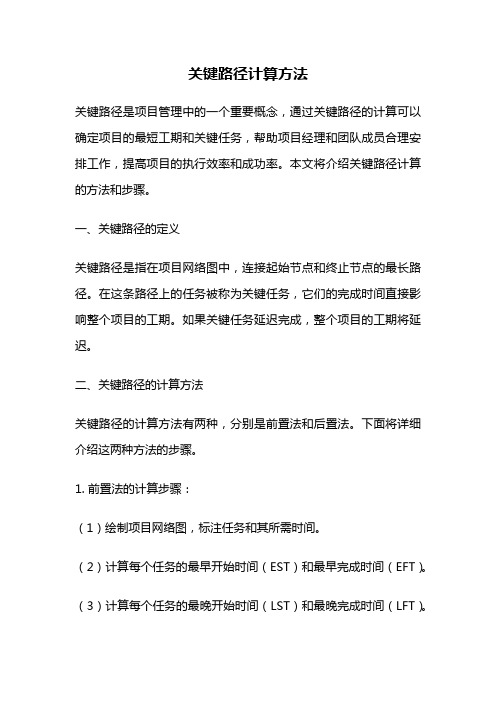
关键路径计算方法关键路径是项目管理中的一个重要概念,通过关键路径的计算可以确定项目的最短工期和关键任务,帮助项目经理和团队成员合理安排工作,提高项目的执行效率和成功率。
本文将介绍关键路径计算的方法和步骤。
一、关键路径的定义关键路径是指在项目网络图中,连接起始节点和终止节点的最长路径。
在这条路径上的任务被称为关键任务,它们的完成时间直接影响整个项目的工期。
如果关键任务延迟完成,整个项目的工期将延迟。
二、关键路径的计算方法关键路径的计算方法有两种,分别是前置法和后置法。
下面将详细介绍这两种方法的步骤。
1. 前置法的计算步骤:(1)绘制项目网络图,标注任务和其所需时间。
(2)计算每个任务的最早开始时间(EST)和最早完成时间(EFT)。
(3)计算每个任务的最晚开始时间(LST)和最晚完成时间(LFT)。
(4)根据计算得到的EST、EFT、LST、LFT,确定每个任务的浮动时间(TF)。
(5)找出浮动时间为0的任务,这些任务即为关键任务。
(6)按照关键任务的排列顺序,确定关键路径。
2. 后置法的计算步骤:(1)绘制项目网络图,标注任务和其所需时间。
(2)计算每个任务的最晚开始时间(LST)和最晚完成时间(LFT)。
(3)计算每个任务的最早开始时间(EST)和最早完成时间(EFT)。
(4)根据计算得到的EST、EFT、LST、LFT,确定每个任务的浮动时间(TF)。
(5)找出浮动时间为0的任务,这些任务即为关键任务。
(6)按照关键任务的排列顺序,确定关键路径。
三、关键路径计算的应用关键路径计算可以帮助项目经理和团队成员合理安排工作,提高项目的执行效率和成功率。
具体应用包括以下几个方面:1. 确定项目的最短工期:通过关键路径的计算,可以确定项目的最短工期,避免工期延误和浪费资源。
2. 优化资源分配:关键路径计算可以帮助项目经理合理安排资源,避免资源过度或不足,提高资源利用率。
3. 提前预警和风险控制:通过关键路径的计算,可以提前预警可能延误的任务,及时采取措施进行调整和风险控制。
关键路径名词解释
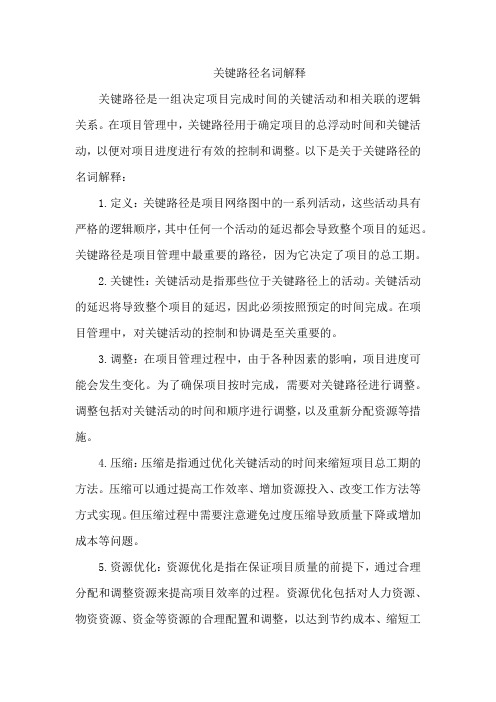
关键路径名词解释关键路径是一组决定项目完成时间的关键活动和相关联的逻辑关系。
在项目管理中,关键路径用于确定项目的总浮动时间和关键活动,以便对项目进度进行有效的控制和调整。
以下是关于关键路径的名词解释:1.定义:关键路径是项目网络图中的一系列活动,这些活动具有严格的逻辑顺序,其中任何一个活动的延迟都会导致整个项目的延迟。
关键路径是项目管理中最重要的路径,因为它决定了项目的总工期。
2.关键性:关键活动是指那些位于关键路径上的活动。
关键活动的延迟将导致整个项目的延迟,因此必须按照预定的时间完成。
在项目管理中,对关键活动的控制和协调是至关重要的。
3.调整:在项目管理过程中,由于各种因素的影响,项目进度可能会发生变化。
为了确保项目按时完成,需要对关键路径进行调整。
调整包括对关键活动的时间和顺序进行调整,以及重新分配资源等措施。
4.压缩:压缩是指通过优化关键活动的时间来缩短项目总工期的方法。
压缩可以通过提高工作效率、增加资源投入、改变工作方法等方式实现。
但压缩过程中需要注意避免过度压缩导致质量下降或增加成本等问题。
5.资源优化:资源优化是指在保证项目质量的前提下,通过合理分配和调整资源来提高项目效率的过程。
资源优化包括对人力资源、物资资源、资金等资源的合理配置和调整,以达到节约成本、缩短工期的目的。
6.风险管理:在项目管理过程中,风险是不可避免的。
风险管理是通过识别、评估、控制和缓解项目风险的过程。
对于关键路径上的风险,需要进行重点关注和控制,以避免对整个项目造成重大影响。
7.优先级:在项目管理中,有时需要对关键活动进行优先级排序。
优先级是根据活动的重要性和紧急性进行排序的指标。
通过优先级排序,可以更好地分配资源和时间,确保项目的顺利进行。
8.监控:监控是对项目进度和关键路径上的活动进行跟踪和控制的过程。
通过监控,可以及时发现项目进度中的问题并及时采取相应的措施进行调整和改进。
同时监控也可以为决策者提供及时的决策支持,以便更好地把握项目的进展情况。
工作计划中的关键路径分析与优化
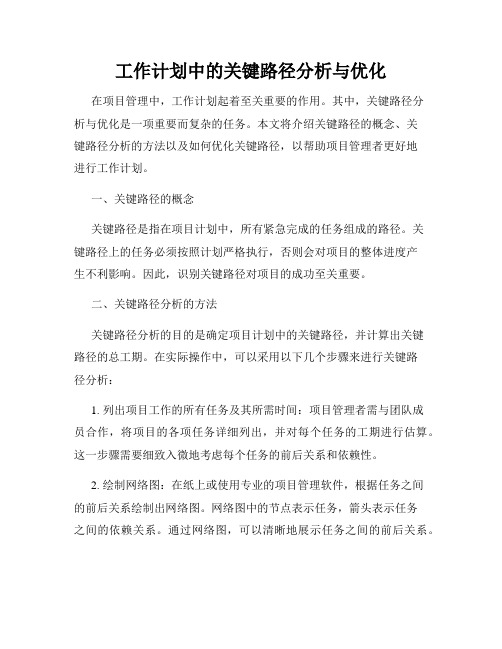
工作计划中的关键路径分析与优化在项目管理中,工作计划起着至关重要的作用。
其中,关键路径分析与优化是一项重要而复杂的任务。
本文将介绍关键路径的概念、关键路径分析的方法以及如何优化关键路径,以帮助项目管理者更好地进行工作计划。
一、关键路径的概念关键路径是指在项目计划中,所有紧急完成的任务组成的路径。
关键路径上的任务必须按照计划严格执行,否则会对项目的整体进度产生不利影响。
因此,识别关键路径对项目的成功至关重要。
二、关键路径分析的方法关键路径分析的目的是确定项目计划中的关键路径,并计算出关键路径的总工期。
在实际操作中,可以采用以下几个步骤来进行关键路径分析:1. 列出项目工作的所有任务及其所需时间:项目管理者需与团队成员合作,将项目的各项任务详细列出,并对每个任务的工期进行估算。
这一步骤需要细致入微地考虑每个任务的前后关系和依赖性。
2. 绘制网络图:在纸上或使用专业的项目管理软件,根据任务之间的前后关系绘制出网络图。
网络图中的节点表示任务,箭头表示任务之间的依赖关系。
通过网络图,可以清晰地展示任务之间的前后关系。
3. 计算每个任务的最早开始时间(EST)和最早结束时间(EFT):从网络图中确定每个任务的最早开始时间和最早结束时间,即在没有任何延误的情况下,任务能够最早开始和完成的时间。
4. 计算每个任务的最晚开始时间(LST)和最晚结束时间(LFT):从网络图中倒推每个任务的最晚开始时间和最晚结束时间,即在不影响项目进度的前提下,任务最晚能够开始和完成的时间。
5. 计算总工期并确定关键路径:通过比较每个任务的最早结束时间和最晚结束时间,可以确定项目的总工期。
同时,关键路径即为最长的总工期所经过的路径。
三、关键路径优化关键路径分析可以帮助项目管理者准确地确定项目的关键任务和关键路径,从而提前预知风险并做出相应应对措施。
然而,在实践中,关键路径上的任务往往非常复杂,很难完全按计划进行。
因此,项目管理者需要针对关键路径进行优化,以保证项目的进度和质量。
数据结构关键路径

数据结构关键路径数据结构是计算机科学中非常重要的一门学科,它主要研究数据之间的组织方式和操作方法。
在计算机程序中,数据结构的选择和设计对程序的性能和效率有着重要的影响。
在数据结构中,关键路径是一个关键概念,它指的是一个任务完成所需要的最长时间。
1. 什么是关键路径在项目管理中,关键路径是指在一个项目的所有任务中,完成项目所需要的最长时间路径。
这条路径上的任务是项目完成的关键,如果其中任何一个任务延迟,整个项目的进度都会受到影响。
在数据结构中,关键路径指的是在一个算法或操作中,完成所需的最长时间。
它是算法或操作的瓶颈,决定了整个操作的效率。
2. 关键路径的计算方法计算关键路径的方法主要有两种:事件法和任务法。
事件法是一种图论的方法,通过绘制和分析项目的网络图来确定关键路径。
任务法是一种优化方法,通过对任务进行排序和计算来确定关键路径。
在数据结构中,计算关键路径通常是通过分析算法的复杂度来完成的。
算法的复杂度可以分为时间复杂度和空间复杂度,其中时间复杂度是计算算法执行所需的时间,空间复杂度是计算算法执行所需的空间。
通过分析算法的复杂度,可以确定算法的关键路径。
3. 关键路径的应用关键路径在数据结构中有着广泛的应用。
在算法设计中,关键路径可以帮助程序员找到算法的瓶颈并进行优化。
通过优化关键路径上的操作,可以提高算法的效率和性能。
此外,关键路径还可以应用于网络流量分析、图像处理、数据压缩等领域。
在网络流量分析中,关键路径可以帮助分析网络中的瓶颈和拥堵点,从而优化网络结构和提高传输效率。
在图像处理中,关键路径可以帮助找到图像处理的关键步骤,从而提高图像处理的速度和质量。
在数据压缩中,关键路径可以帮助找到数据压缩的关键操作,从而提高数据的压缩比例。
4. 关键路径的挑战尽管关键路径在数据结构中有着广泛的应用,但它也面临一些挑战。
首先,计算关键路径的过程通常是复杂且耗时的,需要对算法进行详细的分析和计算。
其次,关键路径可能随着算法或操作的不同而变化,需要根据具体情况进行调整和优化。
关键路径和非关键路径的定义
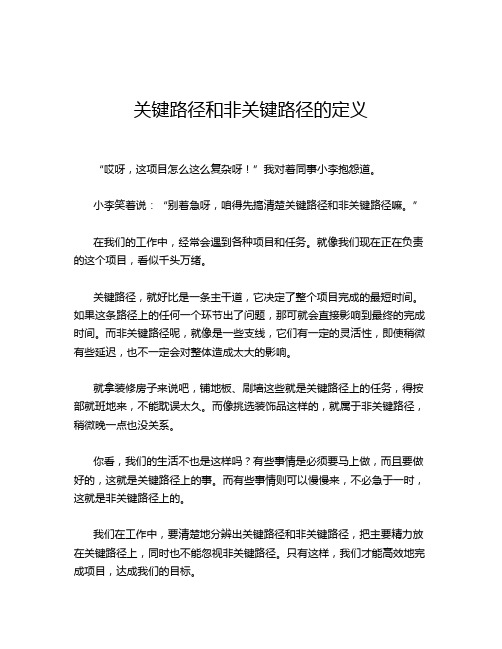
关键路径和非关键路径的定义“哎呀,这项目怎么这么复杂呀!”我对着同事小李抱怨道。
小李笑着说:“别着急呀,咱得先搞清楚关键路径和非关键路径嘛。
”
在我们的工作中,经常会遇到各种项目和任务。
就像我们现在正在负责的这个项目,看似千头万绪。
关键路径,就好比是一条主干道,它决定了整个项目完成的最短时间。
如果这条路径上的任何一个环节出了问题,那可就会直接影响到最终的完成时间。
而非关键路径呢,就像是一些支线,它们有一定的灵活性,即使稍微有些延迟,也不一定会对整体造成太大的影响。
就拿装修房子来说吧,铺地板、刷墙这些就是关键路径上的任务,得按部就班地来,不能耽误太久。
而像挑选装饰品这样的,就属于非关键路径,稍微晚一点也没关系。
你看,我们的生活不也是这样吗?有些事情是必须要马上做,而且要做好的,这就是关键路径上的事。
而有些事情则可以慢慢来,不必急于一时,这就是非关键路径上的。
我们在工作中,要清楚地分辨出关键路径和非关键路径,把主要精力放在关键路径上,同时也不能忽视非关键路径。
只有这样,我们才能高效地完成项目,达成我们的目标。
总之,明白关键路径和非关键路径的区别,对我们的工作和生活都有着重要的意义呀!。
关键路径及关键路径变化的确定原则
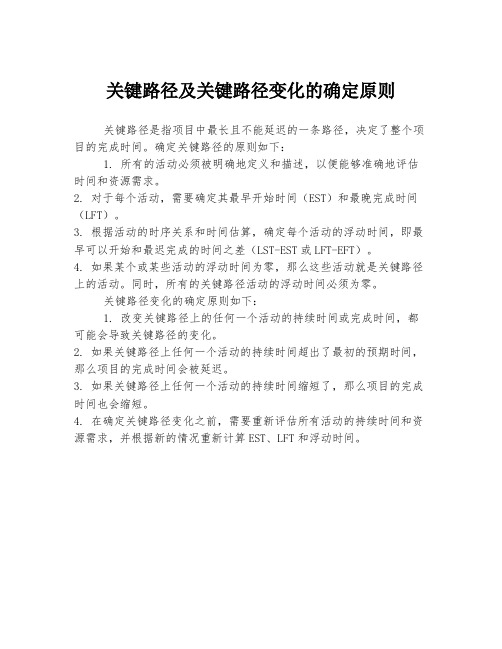
关键路径及关键路径变化的确定原则
关键路径是指项目中最长且不能延迟的一条路径,决定了整个项目的完成时间。
确定关键路径的原则如下:
1. 所有的活动必须被明确地定义和描述,以便能够准确地评估时间和资源需求。
2. 对于每个活动,需要确定其最早开始时间(EST)和最晚完成时间(LFT)。
3. 根据活动的时序关系和时间估算,确定每个活动的浮动时间,即最早可以开始和最迟完成的时间之差(LST-EST或LFT-EFT)。
4. 如果某个或某些活动的浮动时间为零,那么这些活动就是关键路径上的活动。
同时,所有的关键路径活动的浮动时间必须为零。
关键路径变化的确定原则如下:
1. 改变关键路径上的任何一个活动的持续时间或完成时间,都可能会导致关键路径的变化。
2. 如果关键路径上任何一个活动的持续时间超出了最初的预期时间,那么项目的完成时间会被延迟。
3. 如果关键路径上任何一个活动的持续时间缩短了,那么项目的完成时间也会缩短。
4. 在确定关键路径变化之前,需要重新评估所有活动的持续时间和资源需求,并根据新的情况重新计算EST、LFT和浮动时间。
工作计划中的关键路径分析与优化方法
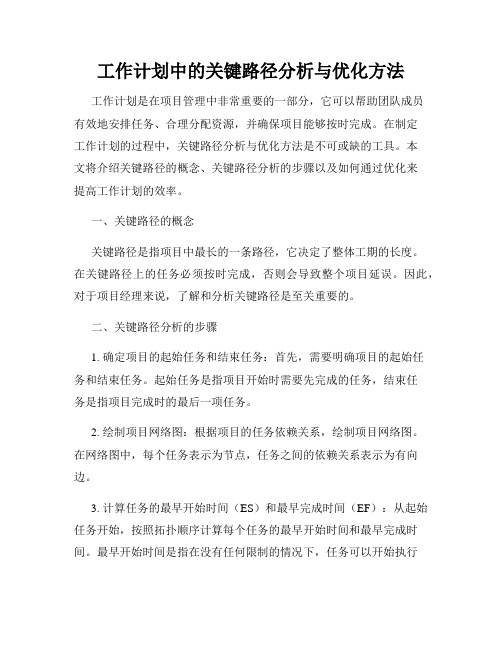
工作计划中的关键路径分析与优化方法工作计划是在项目管理中非常重要的一部分,它可以帮助团队成员有效地安排任务、合理分配资源,并确保项目能够按时完成。
在制定工作计划的过程中,关键路径分析与优化方法是不可或缺的工具。
本文将介绍关键路径的概念、关键路径分析的步骤以及如何通过优化来提高工作计划的效率。
一、关键路径的概念关键路径是指项目中最长的一条路径,它决定了整体工期的长度。
在关键路径上的任务必须按时完成,否则会导致整个项目延误。
因此,对于项目经理来说,了解和分析关键路径是至关重要的。
二、关键路径分析的步骤1. 确定项目的起始任务和结束任务:首先,需要明确项目的起始任务和结束任务。
起始任务是指项目开始时需要先完成的任务,结束任务是指项目完成时的最后一项任务。
2. 绘制项目网络图:根据项目的任务依赖关系,绘制项目网络图。
在网络图中,每个任务表示为节点,任务之间的依赖关系表示为有向边。
3. 计算任务的最早开始时间(ES)和最早完成时间(EF):从起始任务开始,按照拓扑顺序计算每个任务的最早开始时间和最早完成时间。
最早开始时间是指在没有任何限制的情况下,任务可以开始执行的最早时间;最早完成时间是指在没有任何限制的情况下,任务可以完成的最早时间。
4. 计算任务的最晚开始时间(LS)和最晚完成时间(LF):从结束任务开始,按照拓扑逆序计算每个任务的最晚开始时间和最晚完成时间。
最晚开始时间是指在不影响整体工期的前提下,任务必须开始执行的最晚时间;最晚完成时间是指在不影响整体工期的前提下,任务必须完成的最晚时间。
5. 计算任务的总时差(TF):通过计算每个任务的最晚开始时间和最早开始时间的差值,可以得到任务的总时差。
总时差表示了任务可以延误的时间,如果任务的总时差为0,则该任务属于关键路径上的任务。
6. 确定关键路径:根据任务的总时差,确定关键路径上的任务。
关键路径上的任务是项目中最为关键的任务,必须按时完成。
三、关键路径优化方法在关键路径上的任务是决定整个项目工期的关键因素,因此需要通过优化来提高工作计划的效率。
名词解释关键路径

关键路径名词解释一、引言关键路径(Critical Path)是项目管理中的一种重要方法,用于确定项目中各个活动的完成时间和整个项目的最短完成时间。
本报告旨在解释关键路径的概念、计算方法和应用,帮助读者更好地理解关键路径在项目管理中的重要作用。
二、关键路径概念关键路径是指在项目的网络图中,从项目开始到项目结束所经过的一系列活动中,耗时最长的那条路径。
关键路径上的活动被称为关键活动,这些活动的完成时间直接决定了整个项目的完成时间。
三、关键路径计算方法关键路径的计算主要包括以下步骤:1. 确定项目中每个活动的最早开始时间(Earliest Start Time, ES)、最早结束时间(Earliest Finish Time, EF)、最迟开始时间(Latest Start Time, LS)和最迟结束时间(Latest Finish Time, LF)。
2. 计算每个活动的总时差(Total Float Time, T),公式为:T = LF - EF或 T = LS - ES。
总时差为零的活动或路径即为关键路径。
四、关键路径应用关键路径在项目管理中有以下应用:1. 确定项目的最短完成时间:通过关键路径法,可以计算出项目的最短完成时间,为项目团队提供明确的时间目标。
2. 资源分配:关键路径可以帮助项目经理识别关键活动,从而将有限的资源优先分配给这些活动,提高项目效率。
3. 风险分析:关键路径上的活动对项目完成时间有直接影响,项目团队可以针对这些活动进行风险分析,制定相应的预防措施。
4. 进度监控:通过对关键路径的持续跟踪和管理,项目团队可以及时识别偏差,并采取措施来纠正或预防潜在的延误,确保项目能够按时完成。
五、总结关键路径是项目管理中的一种重要方法,通过识别关键路径,项目团队可以更好地控制项目进度、资源分配和风险管理。
掌握关键路径的概念和计算方法,有助于项目经理提高项目管理的效率和效果。
关键路线法(CPM)

任务名称
工期(日)
最早 最迟开始 结束 开始 结束
总时差
1
写报告
2
6/16 6/17 6/16 6/17
0
2
审批
1
6/20 6/20 6/20 6/20
0
3
借款
3
6/21 6/23 6/21 6/23
活动名称
紧前工序
活动时间
A
--
4
F
C、D
9
B
--
6
G
C、D
7
C
A
6
H
E、F
4
D
B
7
I
G
8
E
B
5
A
B
C
E
G
I
H
F
D
绘制网络图
时差计算
活动
工时
ES
LS
EF
LF
时差
A
4
0
3
4
7
3
B
6
0
0
6
6
0
C
6
4
7
10
13
3
D
7
6
6
13
13
0
E
5
6
19
11
24
13
F
9
13
15
22
24
2
G
7
13
13
20
20
0
H
4
22
思路
根据下表中逻辑关系,绘制网络图,并计算各工作的时间参数
B
D
G
2
工程管理中的关键路径优化与调整

工程管理中的关键路径优化与调整在工程管理中,关键路径是指工程项目中最长的路径,决定了整个项目的完成时间。
关键路径优化与调整是工程管理中的重要环节,可以有效提高工程项目的效率和质量。
本文将从关键路径的定义和作用、关键路径的优化方法以及关键路径的调整策略三个方面进行论述。
一、关键路径的定义和作用关键路径是指在工程项目中,所有活动的完成时间之和最长的路径。
它决定了整个项目的最短完成时间,一旦关键路径上的任何一个活动延误,整个项目的完成时间都会延误。
因此,关键路径的优化和调整是工程管理中至关重要的一环。
关键路径的作用主要有以下几个方面:1. 确定工程项目的最短完成时间:通过找出关键路径,可以确定工程项目的最短完成时间,为项目的计划和安排提供依据。
2. 控制工程项目的进度:关键路径上的活动是项目进度的关键,只有保证关键路径上的活动按时完成,才能保证整个项目的进度。
3. 风险管理:关键路径的确定可以帮助管理者及时识别项目中的风险点,采取相应的措施进行风险管理,确保项目的成功实施。
二、关键路径的优化方法关键路径的优化是指通过优化关键路径上的活动,缩短项目的完成时间,提高项目的效率。
以下是几种常见的关键路径优化方法:1. 资源调配:通过合理调配资源,将关键路径上的资源利用率最大化,避免资源闲置或过载的情况发生,提高项目的效率。
2. 并行处理:对于关键路径上的活动,可以尝试将其分解为多个子活动,并且并行处理,以缩短活动的完成时间,从而缩短整个项目的完成时间。
3. 优化工序:对于关键路径上的活动,可以通过优化工序,采用更高效的工艺和方法,来缩短活动的完成时间。
4. 增加资源:对于关键路径上的活动,可以考虑增加资源的投入,以加快活动的完成速度,从而缩短项目的完成时间。
三、关键路径的调整策略在实际项目中,由于各种原因,关键路径可能会发生变化,需要及时进行调整。
以下是几种常见的关键路径调整策略:1. 重新规划:当关键路径发生变化时,需要重新规划项目的进度和资源安排,以适应新的关键路径。
关键路径分析

风险评估与应对的基本步骤包括识别潜在风险、评估风险发生的概率和影响程度、制定 风险应对计划、监控风险变化并及时调整计划。
风险评估与应对的技巧
为了有效进行风险评估与应对,可以采用一些技巧,如风险分类与优先级排序、制定应 急预案、风险转移与分散等。这些技巧有助于降低项目风险,提高项目的成功率。
谢谢观看
等。这些技巧有助于提高任务执行效率,缩短项目总时长。
关键链法
关键链法的概念
关键链法是一种项目管理方法,它通过识别项目中的关键路径和关键任务,优化资源配置和时间安排,以提高项目执 行效率。
关键链法的基本步骤
关键链法的基本步骤包括确定项目目标、识别关键路径和关键任务、制定详细的项目计划、监控项目执行情况并及时 调整计划。
项目成本超支
总结词
项目成本超出预算
详细描述
项目成本超支是关键路径分析中另一 个常见问题。这可能是由于资源利用 效率低下、任务执行时间过长或预算 制定不合理导致的。
项目资源不足
总结词
关键任务缺乏必要资源
详细描述
项目资源不足是关键路径分析中一个重要挑战。这可能导致任务执行效率低下或无法按时完成,需要 合理分配和调度资源。
项目风险控制
总结词
项目风险未得到有效控制
VS
详细描述
项目风险控制是关键路径分析中的重要环 节。需要对项目过程中可能出现的风险进 行识别、评估和控制,以确保项目的顺利 进行。
06
关键路径分析案例研究
案例一:大型建筑项目的关键路径分析
总结词
合理规划、资源优化
详细描述
大型建筑项目涉及多个分项工程和多个承包商,通过关键路径分析,可以确定项目的关键路径,从而合理规划资 源和时间,确保项目按时交付。
管理工作计划的关键路径与关键活动
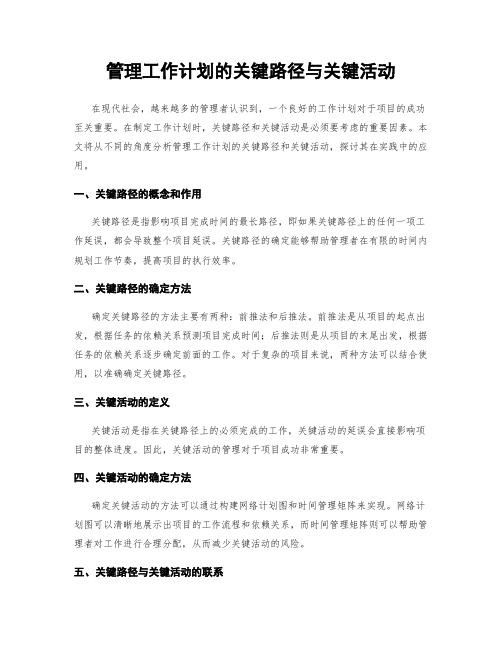
管理工作计划的关键路径与关键活动在现代社会,越来越多的管理者认识到,一个良好的工作计划对于项目的成功至关重要。
在制定工作计划时,关键路径和关键活动是必须要考虑的重要因素。
本文将从不同的角度分析管理工作计划的关键路径和关键活动,探讨其在实践中的应用。
一、关键路径的概念和作用关键路径是指影响项目完成时间的最长路径,即如果关键路径上的任何一项工作延误,都会导致整个项目延误。
关键路径的确定能够帮助管理者在有限的时间内规划工作节奏,提高项目的执行效率。
二、关键路径的确定方法确定关键路径的方法主要有两种:前推法和后推法。
前推法是从项目的起点出发,根据任务的依赖关系预测项目完成时间;后推法则是从项目的末尾出发,根据任务的依赖关系逐步确定前面的工作。
对于复杂的项目来说,两种方法可以结合使用,以准确确定关键路径。
三、关键活动的定义关键活动是指在关键路径上的必须完成的工作,关键活动的延误会直接影响项目的整体进度。
因此,关键活动的管理对于项目成功非常重要。
四、关键活动的确定方法确定关键活动的方法可以通过构建网络计划图和时间管理矩阵来实现。
网络计划图可以清晰地展示出项目的工作流程和依赖关系,而时间管理矩阵则可以帮助管理者对工作进行合理分配,从而减少关键活动的风险。
五、关键路径与关键活动的联系关键路径和关键活动是密不可分的,关键路径上的每个活动都是关键活动。
通过确定关键路径和关键活动,管理者可以将有限资源集中在关键活动上,以确保项目按时完成。
六、关键路径与关键活动的管理挑战在管理关键路径和关键活动时,管理者可能会面临一系列挑战。
例如,工作任务之间的依赖关系复杂,难以准确判断关键路径;资源分配不均衡,导致关键活动的风险增加等。
管理者需要具备良好的沟通协调能力和资源管理经验,以应对这些挑战。
七、关键路径与关键活动的优势和劣势关键路径和关键活动有其独特的优势和劣势。
优势在于可以帮助管理者准确掌握项目的进度和资源分配情况,降低项目风险;劣势在于难以处理复杂的依赖关系和资源冲突。
关键路径是最长的还是最短的

关键路径是最长的还是最短的
关键路径是最长的还是最短的,关键路径是事件结点网络中( )
首先要知道什么是关键路径,关键路径是项目计划中最长的一套路径,通俗点说因为关键路径最长,所以只有保证它做完了,才能保证项目做完了,所以说它最“关键”。
在图中可以看到,路径A耗时最长,所以A最“关键”。
A的用时为28,故答案为A、B。
简介
路径是使用绘图工具创建的任意形状的曲线,用它可勾勒出物体的轮廓,所以也称之为轮廓线。
为了满足绘图的需要,路径又分为开放路径和封闭路径。
GIMP/ Adobe illustrator中所有的矢量图都是由路径构成的。
绘制矢量图就是以为着路径的建立和编辑。
一条路径由若干条线段组成,
其中可能包含直线和各种曲线线段。
为了更好的绘制和修改路径,每个线段的两端均有锚点(Anchor Point)可将其固定,通过移动锚点,可以修改线段的位置和改变路径的形状。
另外,非矢量绘图工具中,也存在路径概念。
关键路径方法

关键路径方法关键路径方法是项目管理中一个重要的工具,它可以帮助项目经理在制定计划和进度时进行有效的决策和跟踪。
本文将从什么是关键路径、如何识别关键路径、关键路径的作用以及如何应用关键路径方法四个方面进行详细介绍。
什么是关键路径?关键路径是指在项目网络图中,连接起始节点与终止节点之间的最长路径。
它代表了项目的最短工期,也就是完成整个项目所需要的最短时间。
在关键路径上的任务被称为关键任务,其完成时间对项目的整体工期具有决定性的影响。
如何识别关键路径?识别关键路径的第一步是构建项目网络图,该图由一系列的任务节点和任务之间的依赖关系所组成。
在网络图中,每个任务都有预计的持续时间。
通过对任务之间的依赖关系和持续时间进行分析,可以确定哪些任务是关键任务,从而确定项目的关键路径。
关键路径的作用是什么?关键路径可以帮助项目经理进行有效的计划和调度,保证项目按时交付。
一旦识别出关键路径,项目经理可以集中资源和注意力在关键任务上,确保其按计划完成。
同时,关键路径还可以帮助项目经理识别出可能的风险和延误因素,提前做好风险管理和应对策略。
如何应用关键路径方法?在项目管理中,应用关键路径方法需要以下几个步骤:1. 确定项目的任务清单:明确项目中的所有任务,并确定它们之间的依赖关系。
2. 估算任务的持续时间:对每个任务进行估算,确定其完成所需要的时间。
3. 构建项目网络图:将任务和依赖关系转化为图形表示,以便更直观地进行分析和演算。
4. 确定关键路径:通过计算每个任务的最早开始时间和最早完成时间,找出关键路径。
5. 管理关键任务:将资源和注意力集中在关键任务上,确保其按计划完成。
6. 跟踪进度:持续跟踪关键任务的进度,并根据实际情况进行调整和优化。
总结:关键路径方法是项目管理中一种重要的工具,在项目计划和进度管理中起着关键的作用。
通过识别关键路径,项目经理可以有效地分配资源、管理风险和保证项目的按时完成。
因此,在项目管理中运用关键路径方法,可以提高项目管理的效率和成功率,实现项目目标的顺利达成。
关键路径问题的解决方法心得和体会和感悟

关键路径问题的解决方法一、关键路径问题的定义关键路径是指在项目管理中,指的是在不影响整个项目完成时间的前提下,完成某项任务所需要的最短时间路径。
也就是说,如果这条路径上的任何一个任务出现了延误,都会直接导致整个项目的延误。
解决关键路径问题对于项目的整体进度控制至关重要。
二、关键路径问题的常见原因1.资源不足:在项目进行中,可能会出现人力、物力、财力等资源不足的情况,导致关键任务的完成时间延误。
2.任务依赖关系复杂:项目中的任务之间存在复杂的依赖关系,一旦出现环节延误,就会影响整个项目的进度。
3.管理不当:项目管理过程中,可能存在交流不畅、决策不及时等管理不当的情况,导致关键任务无法按时完成。
4.外部环境因素:外部环境的改变,比如市场需求、政策法规等因素的变化,可能会对项目的进度产生影响。
三、解决关键路径问题的方法1.资源优化:对资源进行合理规划和分配,确保在关键任务完成时有足够的人力、物力、财力支持。
2.任务分解:将复杂的任务进行细化分解,明确每个子任务的完成时间和依赖关系,有利于更精准地控制关键路径上的任务。
3.缓冲路径计划:在关键路径之外,预留一定的时间作为缓冲,以防止非关键任务的延误对整个项目产生影响。
4.增加交叉培训:对项目团队成员进行交叉培训,增强团队的协作能力和应对突发情况的能力,提高应对关键路径问题的灵活性。
5.利用项目管理工具:借助项目管理软件,实时监控关键路径上任务的进度,及时发现问题并进行调整。
四、关键路径问题的解决方法的体会和感悟在项目管理中,关键路径问题是一个比较棘手的问题,但通过对问题的深入分析和合理的应对措施,可以有效解决关键路径问题,提高项目的整体进度控制能力。
在实际工作中,我们需要密切关注项目进度的情况,及时发现关键路径上可能存在的问题,从而采取针对性的措施进行解决。
作为项目负责人,更需要对团队的资源规划和任务分解进行详细的考量和分析,确保项目整体进度的可控性。
在不断的实践中,我们可以积累丰富的解决关键路径问题的经验,为今后的项目管理工作提供可靠的支持和保障。
项目关键路径的定义
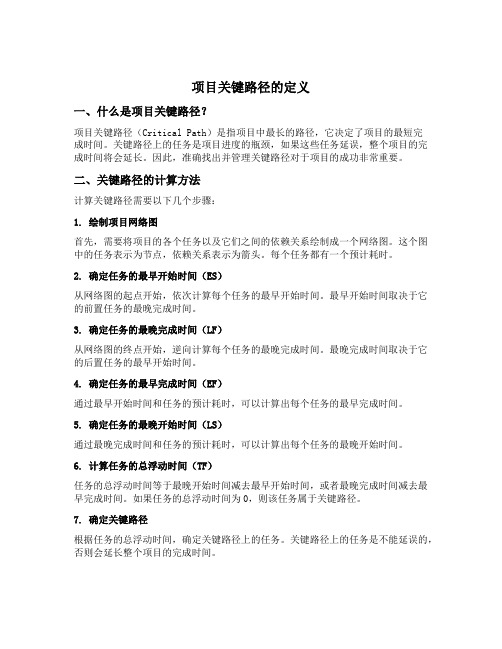
项目关键路径的定义一、什么是项目关键路径?项目关键路径(Critical Path)是指项目中最长的路径,它决定了项目的最短完成时间。
关键路径上的任务是项目进度的瓶颈,如果这些任务延误,整个项目的完成时间将会延长。
因此,准确找出并管理关键路径对于项目的成功非常重要。
二、关键路径的计算方法计算关键路径需要以下几个步骤:1. 绘制项目网络图首先,需要将项目的各个任务以及它们之间的依赖关系绘制成一个网络图。
这个图中的任务表示为节点,依赖关系表示为箭头。
每个任务都有一个预计耗时。
2. 确定任务的最早开始时间(ES)从网络图的起点开始,依次计算每个任务的最早开始时间。
最早开始时间取决于它的前置任务的最晚完成时间。
3. 确定任务的最晚完成时间(LF)从网络图的终点开始,逆向计算每个任务的最晚完成时间。
最晚完成时间取决于它的后置任务的最早开始时间。
4. 确定任务的最早完成时间(EF)通过最早开始时间和任务的预计耗时,可以计算出每个任务的最早完成时间。
5. 确定任务的最晚开始时间(LS)通过最晚完成时间和任务的预计耗时,可以计算出每个任务的最晚开始时间。
6. 计算任务的总浮动时间(TF)任务的总浮动时间等于最晚开始时间减去最早开始时间,或者最晚完成时间减去最早完成时间。
如果任务的总浮动时间为0,则该任务属于关键路径。
7. 确定关键路径根据任务的总浮动时间,确定关键路径上的任务。
关键路径上的任务是不能延误的,否则会延长整个项目的完成时间。
三、为什么关键路径很重要?关键路径对项目的成功至关重要,原因如下:1. 决定项目的最短完成时间关键路径上的任务决定了项目的最短完成时间。
如果关键路径上的任务延误,整个项目的完成时间将会延长。
2. 优化资源分配通过识别关键路径,项目经理可以更好地分配资源。
关键路径上的任务需要优先考虑,确保资源能够及时投入。
3. 提前解决问题关键路径上的任务通常是项目进度的瓶颈,如果这些任务出现问题,整个项目的进度将会受到影响。
- 1、下载文档前请自行甄别文档内容的完整性,平台不提供额外的编辑、内容补充、找答案等附加服务。
- 2、"仅部分预览"的文档,不可在线预览部分如存在完整性等问题,可反馈申请退款(可完整预览的文档不适用该条件!)。
- 3、如文档侵犯您的权益,请联系客服反馈,我们会尽快为您处理(人工客服工作时间:9:00-18:30)。
一.实验名称:关键路径二.实验目的:1.熟悉图的存储结构2.掌握求关键路径的算法3.了解实际问题的求解效率与采用何种存储结构和算法有密切关系三.程序#include "stdio.h"#include "malloc.h"//-----图的邻接表存储结构-----typedef struct ArcNode{ //弧结点int adjvex; //该弧指向的顶点的序号struct ArcNode *nextarc; //指向下一条弧的指针int info; //该弧相关信息的指针}ArcNode,*Arc;typedef struct VNode{ //顶点char data; //顶点信息ArcNode *firstarc; //指向第一条依附该顶点的弧}VNode,AdjList[20];typedef struct{ //图AdjList vertices; //存储图的顶点的数组int vexnum,arcnum; //图的当前定点数和弧数}ALGraph;typedef struct{ //栈int *base,*top; //栈底和栈顶指针int stacksize; //栈的长度}SqStack;void CreateG(ALGraph &G,int m) //建顶点数为m的图{int i,j,k,w; Arc p,q;G.vexnum=m;G.arcnum=0; //对图进行初始化for(i=0;i<m;i++) //输入m个顶点的信息{printf("\nplease input VNode%d data:",i);scanf("%c",&G.vertices[i].data);}for(i=1;i<=m;i++) //给各顶点连以其为尾的弧{printf("\nplease input VNode%d outarc:",i);scanf("%d",&j); //输入该顶点第一条弧指向的顶点在存储数组中的序号if(!j) G.vertices[i-1].firstarc=NULL; //j=0该顶点没有以其为尾的弧else{ G.arcnum++; //弧数增加1p=(Arc)malloc(sizeof(ArcNode)); //为该顶点开辟第一个弧结点p->adjvex=j-1; //该弧指向的顶点序号G.vertices[i-1].firstarc=p; //把弧连到该顶点for(;;) //建立该顶点的其他以其为尾的弧结点{scanf("%d",&k);if(!k) {p->nextarc=NULL;break;}else{G.arcnum++;q=(Arc)malloc(sizeof(ArcNode));q->adjvex=k-1;p->nextarc=q; //前一条弧指向后一条弧}}}}//所有弧结点建立完毕for(i=1;i<=m;i++) //分别输入每个顶点以其为尾的弧的信息{printf("\nplease input arcs'information of VNode%d:",i);p=G.vertices[i-1].firstarc;while(p){scanf("%d",&w);p->info=w;p=p->nextarc;}}printf(“\n”);}void FindInDegree(ALGraph G,int*indegree)//求图G各顶点的入度,存入数组indegree中,序号对应于顶点序号{int i;Arc p;indegree=(int *)malloc(G.vexnum*sizeof(int));for(i=0;i<G.vexnum;i++) //indegree[ ]初始化indegree[i]=0;for(i=1;i<=G.vexnum;i++){p=G.vertices[i-1].firstarc; //p指向弧结点while(p){indegree[p->adjvex]++; //通过弧结点储存的指向的顶点序号求各顶点入度p=p->nextarc;}}}void InitStack(SqStack &S) //构建一个空栈S {S.base=(int *)malloc(20*sizeof(int));S.top=S.base;S.stacksize=20;int StackEmpty(SqStack S) //若栈S为空,则返回1,否则0 {if(S.base==S.top) return 1;else return 0;}int Pop(SqStack &S,int &e) //删除S的栈顶元素,并用e返回其值{if(S.top==S.base) return 0;e=*--S.top; return 1;}void Push(SqStack &S,int e) //插入元素e为新的栈顶元素{*S.top++=e;}int TopologicalOrder(ALGraph G,SqStack &T,int ve[ ])//T为拓扑序列顶点栈,S为零入度顶点栈//若G无回路,则用栈T返回G的一个拓扑序列,且函数值为1,否则为0{int i,j,k,*indegree,count; Arc p; SqStack S;FindInDegree(G,indegree); //对各顶点求入度InitStack(S); //建零入度栈for(i=0;i<G.vexnum;i++){if(!indegree[i]) Push(S,i);}InitStack(T); count=0;for(i=0;i<G.vexnum;i++) //初始化ve[i]=0;while(!StackEmpty(S)){Pop(S,j); Push (T,j); ++count; //j号顶点如T栈并计数for(p=G.vertices[j].firstarc; p; p=p->nextarc)k=p->adjvex; //对j号顶点的每个邻接点的入度减1 if(--indegree[k]==0) Push(S,k); //若入度为0,则如栈if(ve[j]+p->info>ve[k]) ve[k]=ve[j]+p->info;}if(count<G.vexnum) return 0; //该有向网有回路else return 1;}int CriticalPath(ALGraph G) //G为有向网,输出G的各项关键活动{int j,k,dut,ee,el,vl[20],ve[20]; char tag; SqStack T;Arc p;if(!TopologicalOrder(G,T,ve)) return 0;for(j=0;j<G.vexnum;j++) //初始化顶点时间的最迟发生时间vl[j]=ve[j];while(!StackEmpty(T)) //按拓扑排逆序求各顶点的v1值for(Pop(T,j),p=G.vertices[j].firstarc;p;p=p->nextarc){k=p->adjvex; dut=p->info; //活动持续时间dut<j,k>if(vl[k]-dut<vl[j]) vl[j]=vl[k]-dut;printf(“\nThe result is:\n”)for(j=0; j<G.vexnum; ++j) //求ee,el和关键活动for(p=G.vertices[j].firstarc; p; p=p->nextarc){k=p->adjvex; dut=p->info;ee=ve[j];el=vl[k]-dut;tag=(ee==el)?'*':' ';printf("dut<%c,%d>=%,ee=%d,el=%3d:%c\n",G.vertices[j].data,G.vertices[k].data,dut,ee,el,tag);//输出关键活动}return 1;}void main(){ALGraph G; int m;printf("please input the number of VNode:");scanf("%d",&m); //输入图的顶点数CreateG(G,m); //创建图CriticalPath(G); //求关键路径}四.运行结果1.输入2.输出一.实验名称:比较3种排序方法的效率二.实验目的1.深刻理解排序的定义和各种排序方法的特点2.了解各种方法的排序过程极其依据的原则3.掌握排序的算法三.程序#include "stdio.h"#include "stdlib.h"#include "time.h"#define swap(x,y) {int t;t=x;x=y;y=t;}long steps1=0,steps2=0,steps3=0; //steps记录排序运行步骤//-----------选择排序-----------int SelectMin(int r[ ],int i) //在r[i…10000]中选择最小的数并返回{int min,j;for(j=min=i;j<=10000;j++)if(r[j]>r[j+1]) min=j+1; steps1=steps1+10001-i;return min;}void Selection(int r[ ]) //选择排序主函数{int i,j;for(i=1;i<10000;++i,steps1++) //选择第小的记录,并交换到位{j=SelectMin(r,i);if(i!=j) swap(r[i],r[j]); //与第个记录交换}}//------------快速排序----------int Partition(int r[ ],int low,int high) //交换r[low…high]的记录,使枢纽记录到位,并返回其所、//在位置,此时在它之前(后)的记录均不大(小)于它{int pivot;r[0]=r[low]; //子用数组的第一个记录作枢纽记录pivot=r[low]; //枢轴记录关键字steps2=steps2+2;while(low<high) //从数组的两端交替的向中间扫描{while(low<high&&r[high]>=pivot) {--high; steps2++;}r[low]=r[high]; steps2++; //将比枢轴记录小的记录交换到低端while(low<high&&r[low]<=pivot) {++low;steps2++;}r[high]=r[low];steps2++; //将比枢轴记录大的记录交换到高端}r[low]=r[0]; steps2++; //枢轴记录到位return low; //返回枢轴所在位置}void QSort(int r[],int low,int high) //对子序r[low…high]作快速排序{int pivotloc;if(low<high) //长度大于1{pivotloc=Partition(r,low,high); //将r[low…high]一分为二QSort(r,low,pivotloc-1); //对子表递归排序,pivotloc是枢轴位置QSort(r,pivotloc+1,high); //对高子表递归排序}steps2=steps2+3;}void Quick(int r[ ]) //快速排序主函数{QSort(r,1,1000);}//------------堆排序-------------void Heap(int r[ ],int i,int m) //调整r[i…m]成大顶堆{ int j,x;x=r[i];j=2*i; steps3=steps3+2;while(j<=m) //沿r[i]较大的孩子结点往下筛选{ if(j<m)if(r[j]>r[j+1]){ j++;steps3++;} //j为r[i]较大记录的下标if(r[j]<x){r[i]=r[j];i=j;j=2*i; steps3=steps3+3;}else{ j=m+1; steps3++;}}r[i]=x;steps3++; //插入}void Heaping(int r[ ],int n) //对含n个数进行堆排序{int i,v,x;for(i=n;i>0;i--,steps3++)r[i]=r[i-1];for(i=n/2;i>=1;i--,steps3++) //把r[n]建成大顶堆Heap(a,i,n);for(v=n;v>=2;v--) //将堆顶记录和当前未经排序子序列r[1…v] { x=r[1]; //中最后一个记录相互交换r[1]=r[v];r[v]=x;Heap(r,1,v-1);steps3=steps3+4; //将r[1…v-1]重新调整成大顶堆}for(i=0;i<n;i++,steps3++)r[i]=r[i+1];}void main(){int r1[10001],r2[10001],r3[10001],i;randomize(); //随机产生10000个不相同的数,存入数组中for(i=1;i<=10000;i++)r1[i]=r2[i]=r3[i]=random(100)+1;Selection(r1); //选择排序Quick(r2); //快速排序Heaping(r3,10000); //堆排序printf("steps1=%ld,steps2=%ld,steps3=%ld\n",steps1,steps2,steps3);} //打印三个排序的总步骤数四.运行结果结论:快速排序效率最高,其次是堆排序,选择排序效率较低。
